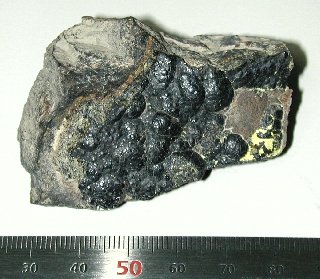What we inhale may get us lung cancer, and it's not only smoking, but there are other things in the air you may least expect. Here are some of them anyway...
Radon Gas
Radon gas is colourless and odourless, but it packs a punch when it comes to lung cancer! Radon gas is formed when radium decomposes, while radium itself is a product when uranium decomposes. Let's make it clear:
Uranium ----> Radium -----> Radon gas
 |
| Location of the Ore Mountains, somewhere between the borders of Germany and Czech Republic. Source: Wikipedia |
Radon gas was put together with lung cancer following a rise in lung cancer cases among miners in the Ore Mountains near Schneeberg , Germany and Jáchymov Czech Republic . Since 1470, the mines there had been a productive source for precious metals including sliver, nickel, bismuth, cobalt and arsenic. Strangely though, most workers in the mines eventually contracted a fatal disease, known as “Bergkrankheit” (mountain sickness), confirmed to be lung cancer later in the 1980s. During the 25 years of the disease, an estimated 60 to 80% of miners had succumbed to the disease.
 |
| Uranium sample from the Ore Mountains. Source: Wikipedia |
It was believed that the lives lost might be related to chemical constituents in the ore, especially arsenic. However, there were early suspicions that “radium emanation” was the prime factor. Considering the richness of uranium in those mines, radium and radon gas would also be present at relatively high concentrations as well. This theory was further supported when measurements showed that the air in those mines could contain up to 18,000 picocuries of radon gas per liter (pCi/L). That’s above 4500 times more than the level of radon “safe” for humans!
However, this did little to hamper the mining of uranium in Colorado , United States. Europe , safety and protection measures were not properly taken. Evidence clearly showed that poorly ventilated uranium mines would lead to lung cancer, yet ventilation of these mines were not carried out, as they were thought to be unnecessary and money-consuming. They eventually paid the price, as 4000 to 5000 lives would be claimed by the disease, a majority of who had worked in those mines.
Behind only smoking, radon gas is the second leading cause of lung cancer in the United States
Asbestos
 |
| An example of asbestos roofing, look at the ruffled edges: that's highly dangerous considering what those fibres can do! |
Asbestos is yet another factor of lung cancer, responsible for 2 to 3% of lung cancer deaths among males in the United Kingdom
The usage of asbestos became increasingly popular late in the 1800s, notably in the Industrial Revolution in Europe , as many realised the potential this “miracle mineral” could have. Commercial asbestos mines were also opened for this purpose and asbestos was widely used throughout the world. It wasn’t until the early 1900s when researchers noticed a large number of deaths and lung problems related to asbestos. It was a shocking discovery, but the public had not been properly informed about the dangers of asbestos exposure, leading to a much higher death rate. Soon however, the usage of asbestos in certain products was banned.
 |
| Asbestos fibres as viewed under a scanning electron microscope. Source: Wikipedia |
The problem with asbestos is that these tiny asbestos fibres get trapped rather easily in our lungs and can remain there for a long time. Accumulation of these fibres can be deadly: one of the reasons is that asbestos is a carcinogen (cancer-causing substance). Research has shown that exposure to asbestos does increases the risk of lung cancer and another kind of cancer related to the thin membranes lining the chest and abdomen, known as mesothelioma (Read more here!). However, this applies mostly to those who are exposed to asbestos to a regular basis, notably workers in the industries mentioned above. That doesn’t mean that other people were completely safe though, as these asbestos fibres can be brought around in the clothing and skin of those exposed! Let’s not forget that living near asbestos mines also greatly increases the risk.
To reduce the risk on contracting asbestos-related lung diseases, workers like these are encouraged to wear appropriate clothing and use protective equipment. Air purification should also be performed properly in households. If possible, try to avoid using these materials.
Other Air Pollutants
There are other air pollutants which are responsible for lung cancer, but their impact aren't as great as the others mentioned earlier. For example, particulate matter, such as dust, soot or liquid particles, may also contribute to lung cancer. Certain gases such as sulphur dioxide and nitrogen dioxide may also bring harm to the lungs, though not necessarily in the form of cancer.
It's not practical to list out every kind of air pollutant and their effects to our lungs. However, it is wise to take note that high-risk groups are more susceptible to the effects of air pollution, for example children and the elderly. Our lungs have cilia which act as filters, plus we can also remove foreign particles by sneezing or coughing. However, some air pollutants (like particulate matter) are small enough to get into the inner portions of the lungs and may lead to adverse effects.
Needless to say, it's about time we do something about the quality of our air. Come on, people:
To go back, click here.
It's not practical to list out every kind of air pollutant and their effects to our lungs. However, it is wise to take note that high-risk groups are more susceptible to the effects of air pollution, for example children and the elderly. Our lungs have cilia which act as filters, plus we can also remove foreign particles by sneezing or coughing. However, some air pollutants (like particulate matter) are small enough to get into the inner portions of the lungs and may lead to adverse effects.
Needless to say, it's about time we do something about the quality of our air. Come on, people:
Let us stop air pollution NOW!To learn more, click here.
To go back, click here.


No comments:
Post a Comment